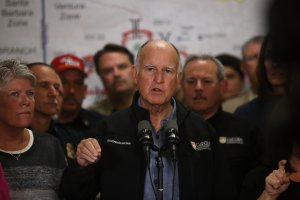Addressing the six massive wildfires continued to burn across Southern California on Saturday, Gov. Jerry Brown did not attempt to paint a rosy picture.

“This is the new normal,” he said of the unusually forceful and sustained Santa Ana winds, unusually dry fall and unusually low humidity that led to the widespread and devastating fires, citing a changing climate in the state.
Brown spoke at a news conference Saturday afternoon in Ventura, where the largest blaze, the Thomas Fire, has smothered 231 square miles and burned down 537 structures. It’s the biggest in Southern California since the Bel-Air fire in 1961.
Other active incidents include the Lilac Fire in San Diego County, Rye Fire in Santa Clarita, Creek Fire near Sylmar, Liberty Fire in Murrieta and Skirball Fire near Bel-Air. Altogether, the large fires have burned more than 175,000 acres this week and destroyed 793 structures, Cal Fire Chief Ken Pimlott said.
Responding to the incidents has required a massive mobilization of resources across California, as well as from five other states. Nearly all of California’s 1,000 fire departments are somehow involved, and 8,500 firefighters were on fire lines across Southern California Saturday, according to Pimlott.
But as climate change pushes weather events to their most extreme, California must better prepare for such incidents begin considering fires as a constant threat, Brown said.
“We’re facing a new reality in this state where fires threaten people’s lives, their property, their neighborhoods, and of course billions and billions of dollars,” Brown said. “We have to have the resources to combat the fires and we have to also invest in managing vegetation and forests, and all the ways we dwell in this very wonderful place, but a place that’s getting hotter.”
Pimlott urged California residents to begin thinking of fires as a year-round threat. “It’s December and it’s amazing to be able to say we aren’t out of fire season,” he said.
What separates this week’s fires from past wind events? “We can all say it’s this duration — how long the winds have been here sustained — as well as the dry conditions that continue throughout the Southland, and just the intensity of the winds,” Pimlott said.
Brown expects the changing climate to exacerbate other problems, including California’s long history of severe droughts. He said he plans to spend the next few months looking into way to better manage the states’ forests in attempt to begin mitigating the effects of climate change.
He urged the state to pull together to address the issue while criticizing the federal government’s response. “It’s a time to do more, not less,” Brown said. “Fires, floods and earthquakes don’t go away.”















